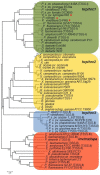Commonalities and differences of T3SSs in rhizobia and plant pathogenic bacteria
- PMID: 24723933
- PMCID: PMC3973906
- DOI: 10.3389/fpls.2014.00114
Commonalities and differences of T3SSs in rhizobia and plant pathogenic bacteria
Abstract
Plant pathogenic bacteria and rhizobia infect higher plants albeit the interactions with their hosts are principally distinct and lead to completely different phenotypic outcomes, either pathogenic or mutualistic, respectively. Bacterial protein delivery to plant host plays an essential role in determining the phenotypic outcome of plant-bacteria interactions. The involvement of type III secretion systems (T3SSs) in mediating animal- and plant-pathogen interactions was discovered in the mid-80's and is now recognized as a multiprotein nanomachine dedicated to trans-kingdom movement of effector proteins. The discovery of T3SS in bacteria with symbiotic lifestyles broadened its role beyond virulence. In most T3SS-positive bacterial pathogens, virulence is largely dependent on functional T3SSs, while in rhizobia the system is dispensable for nodulation and can affect positively or negatively the mutualistic associations with their hosts. This review focuses on recent comparative genome analyses in plant pathogens and rhizobia that uncovered similarities and variations among T3SSs in their genetic organization, regulatory networks and type III secreted proteins and discusses the evolutionary adaptations of T3SSs and type III secreted proteins that might account for the distinguishable phenotypes and host range characteristics of plant pathogens and symbionts.
Keywords: atypical T3SSs; nodulation; pili; plant pathogenic bacteria; plant-associated bacteria; rhizobia; translocator; type III secretion.
Figures




Similar articles
-
Bridging the Gap: Type III Secretion Systems in Plant-Beneficial Bacteria.Microorganisms. 2022 Jan 15;10(1):187. doi: 10.3390/microorganisms10010187. Microorganisms. 2022. PMID: 35056636 Free PMC article.
-
Nodulation outer proteins: double-edged swords of symbiotic rhizobia.Biochem J. 2015 Sep 15;470(3):263-74. doi: 10.1042/BJ20150518. Biochem J. 2015. PMID: 26341483 Review.
-
Assembly, structure, function and regulation of type III secretion systems.Nat Rev Microbiol. 2017 Jun;15(6):323-337. doi: 10.1038/nrmicro.2017.20. Epub 2017 Apr 10. Nat Rev Microbiol. 2017. PMID: 28392566 Review.
-
Innovation and Application of the Type III Secretion System Inhibitors in Plant Pathogenic Bacteria.Microorganisms. 2020 Dec 9;8(12):1956. doi: 10.3390/microorganisms8121956. Microorganisms. 2020. PMID: 33317075 Free PMC article. Review.
-
Who comes first? How plant pathogenic bacteria orchestrate type III secretion.Curr Opin Microbiol. 2006 Apr;9(2):193-200. doi: 10.1016/j.mib.2006.02.006. Epub 2006 Mar 9. Curr Opin Microbiol. 2006. PMID: 16529983 Review.
Cited by
-
Type III secretion system and virulence markers highlight similarities and differences between human- and plant-associated pseudomonads related to Pseudomonas fluorescens and P. putida.Appl Environ Microbiol. 2015 Apr;81(7):2579-90. doi: 10.1128/AEM.04160-14. Epub 2015 Jan 30. Appl Environ Microbiol. 2015. PMID: 25636837 Free PMC article.
-
Identification of Soybean Genes Whose Expression is Affected by the Ensifer fredii HH103 Effector Protein NopP.Int J Mol Sci. 2018 Nov 2;19(11):3438. doi: 10.3390/ijms19113438. Int J Mol Sci. 2018. PMID: 30400148 Free PMC article.
-
Rhizobium-legume symbiosis in the absence of Nod factors: two possible scenarios with or without the T3SS.ISME J. 2016 Jan;10(1):64-74. doi: 10.1038/ismej.2015.103. Epub 2015 Jul 10. ISME J. 2016. PMID: 26161635 Free PMC article.
-
Classical Soybean (Glycine max (L.) Merr) Symbionts, Sinorhizobium fredii USDA191 and Bradyrhizobium diazoefficiens USDA110, Reveal Contrasting Symbiotic Phenotype on Pigeon Pea (Cajanus cajan (L.) Millsp).Int J Mol Sci. 2019 Mar 3;20(5):1091. doi: 10.3390/ijms20051091. Int J Mol Sci. 2019. PMID: 30832430 Free PMC article.
-
QTL Mapping and Data Mining to Identify Genes Associated With the Sinorhizobium fredii HH103 T3SS Effector NopD in Soybean.Front Plant Sci. 2020 May 19;11:453. doi: 10.3389/fpls.2020.00453. eCollection 2020. Front Plant Sci. 2020. PMID: 32508850 Free PMC article.
References
-
- Alavi S. M., Sanjari S., Durand F., Brin C., Manceau C., Poussier S. (2008). Assessment of the genetic diversity of Xanthomonas axonopodis pv. phaseoli and Xanthomonas fuscans subsp. fuscans as a basis to identify putative pathogenicity genes and a type III secretion system of the SPI-1 family by multiple suppression subtractive hybridizations. Appl. Environ. Microbiol. 74, 3295–3301 10.1128/AEM.02507-07 - DOI - PMC - PubMed
-
- Alfano J. R., Charkowski A. O., Deng W. L., Badel J. L., Petnicki-Ocwieja T., van Dijk K., et al. (2000). The Pseudomonas syringae Hrp pathogenicity island has a tripartite mosaic structure composed of a cluster of type III secretion genes bounded by exchangeable effector and conserved effector loci that contribute to parasitic fitness and pathogenicity in plants. Proc. Natl. Acad. Sci. U.S.A. 97, 4856–4861 10.1073/pnas.97.9.4856 - DOI - PMC - PubMed
Publication types
LinkOut - more resources
Full Text Sources
Other Literature Sources

